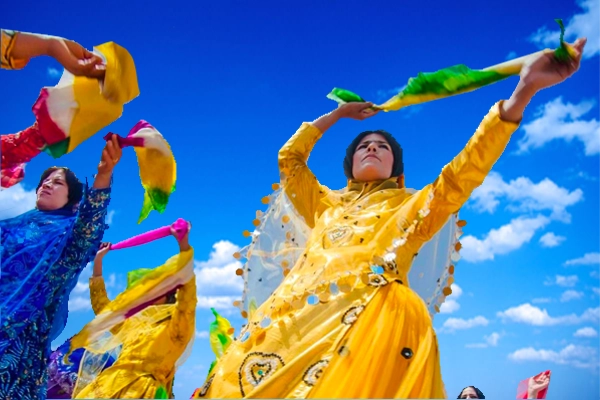
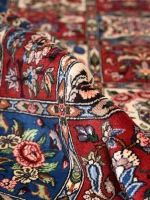
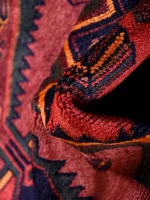
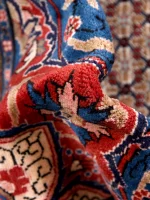
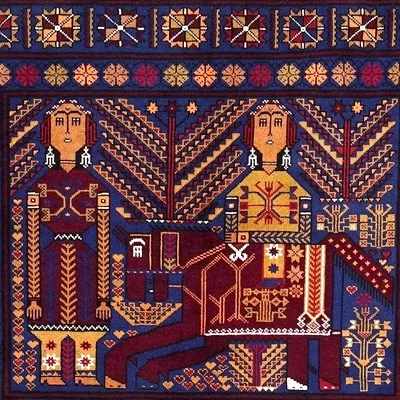
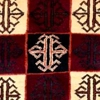
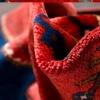
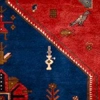
Step into a world of rich heritage and captivating artistry handcrafting with our exquisite collection of hand-knotted Persian tribal rugs. Each rug we offer is a testament to the cultural diversity in the villages scattered throughout tribes around Iran, where different materials and skilled artisans have produced magnificent works of art since 1918.
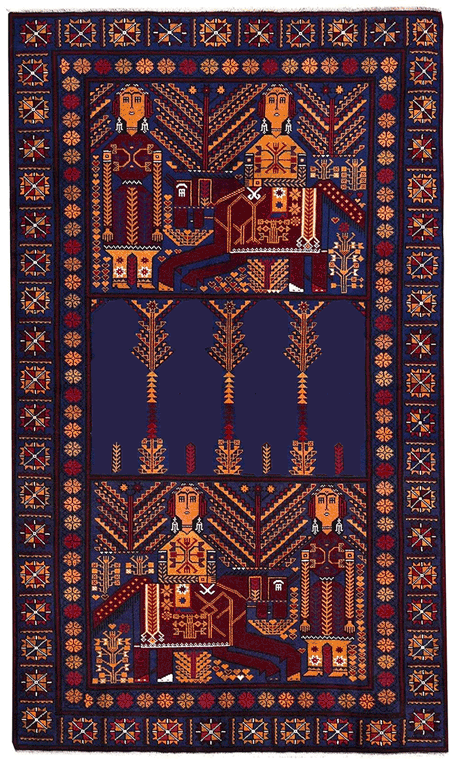
Step into the captivating world of tribal women whose legacy of art unravels a profound history of courage, resilience, and cultural richness. Through their nomadic or village lives, these remarkable artisans poured their essence into each tribal Persian rug, showcasing their traditional dances, embracing the joyful moments, and weaving their connection to nature. With a masterful blend of raw materials and vibrant colours, every Persian tribal carpet became a testament to their innate artistic spirit, woven into the very fabric of their being.
No matter where they lived, they harnessed the raw power of nature; these artists transformed its elements into a kaleidoscope of colors and patterns. Their enduring hand-woven Persian tribal carpets became timeless companions, adorning village houses and nomadic tents, constantly reminding them of life’s inherent beauty.
Amidst the harshest winters, their hand-knotted carpets emerged as beacons, promising the sweet hope of vibrant springs—a testament to the resilience and the cyclical nature of joy.
We are prepared to mesmerize you as we unveil antique Persian tribal carpets of stories woven into every thread; we are ready to adorn your home with the beauty of a thousand tales.

Iran, possessing the most extensive collection of tribal communities, is one of the most significant epicenters of tribal life globally. Within these tribes, eight of the most prominent are outlined below:
Numerous specialized historians in carpet weaving acknowledge tribal handwoven rugs as one of the oldest handmade carpets. The weaving techniques and knot styles commonly employed in village rug-making predominantly stem from the “NIM-LOOL” loom technique.
Among Iran’s nomadic tribes, intricate rugs are woven flat.
The concept of mental design refers to creating patterns without a designer’s predetermined plans. An individual’s taste guides these designs. The surrounding environment, such as beautiful landscapes, everyday objects, and animals, influences these imaginary designs. Each of these symbolic patterns represents the culture associated with their respective tribes. This process led to the creation of the finest traditional handwoven Persian rugs, which have gained worldwide recognition due to the simplicity of their patterns.
The dimensions of these authentic Iranian tribal rugs typically fall within the following range:
Runner lengths: 2 meters, 3 meters, 4 meters, 5 meters
In the nomadic lifestyle, skill in weaving, especially in earlier times, held significant importance, and mastery of spinning thread from animal wool was essential knowledge. Hand-spun goat wool was commonly used for carpets due to its attributes, such as luster and durability. This type of wool exhibited its shine and ensured health benefits.
In the warp and weft of the carpets, these same wools and linen or cotton threads were primarily used. Linen fibers were extracted from a plant stem known as flax. The dyes employed for coloring the raw wool were entirely natural and plant-based, contributing to the inherent stability of the colors.
The art of weaving in tribal rugs is predominantly carried out by women and young ladies, serving as a local source of income for them. The weaving style and knotting technique in tribal rugs are flat-woven.
Tribal rugs are created using imaginary-weaving techniques. The tribal weavers function like camera lenses, capturing rare and unique scenes from nature, wildlife, birds, and objects used in the nomadic lifestyle. These images are meticulously stored in the minds and memories of the weavers and are transformed into valuable and natural handicrafts. The woven patterns express the simplicity and authenticity of nomadic life. It’s worth noting that the combination of broken and angular geometric shapes is also a prominent feature of the designs found in Iranian tribal rugs.
Six of the most famous tribes of Iranian carpet weavers, renowned and recognized worldwide for their valuable woven carpets, are as follows:
They are a group of Turkmen who, in the past years, resided in the Caucasus region and around Lake Urmia City. After a while, by the order of Safavid and Nader Shah (the Afshar) migrated to the vicinity of Kerman city. The Afshar carpets were woven differently depending on the region. In the Shahrbabak area, the carpets were incorporated in a single-weft structure, while in the Sirjan region, double-knots techniques were used. The distinction between the carpets woven in Shahrbabak and Sirjan lies in the designs; Shahrbabak carpets tend to have intricate and busy patterns, whereas Sirjan carpets feature more secluded designs.
The Bakhtiari tribe originates from the Kurdish regions and resides in an area stretching from Isfahan to the southern parts of Malayer. Their carpet designs predominantly feature a pattern of squares, commonly called the “Kheshti” pattern design. Within these squares, motifs of flowers, branches, birds, and animals are intricately woven. The Bakhtiari carpets incorporate a vibrant color palette, including bright red, brown, green, yellow, ivory, and white shades. However, alongside the well-known brick pattern, Bakhtiari carpets also encompass other designs such as “lachak” and “toranj” (the medallion corner design), as well as the distinct “Lori Bakhtiari” pattern.
Among the most authentic tribes of Iran, they have endeavoured to preserve ancient customs and traditions in their way of life up to the present day. The genuine carpets of Iranian Baloch tribes blend elements from Afghan carpet designs and Iranian Turkmen designs. However, at times, a distinct touch of creativity is also incorporated. Patterns such as the Tree of Life and Camel Footprints are commonly featured in their designs. These carpets are predominantly woven using black wool and Persian knots. They are mostly flat-woven carpets. The colours used in these carpets are primarily shades of red, blue, chocolate brown, Ivory, and orange. Additionally, these carpets often come in elongated and narrow sizes.
Luri tribes are scattered across various regions of Iran. The geometric patterns, animals, and ancient symbols related to the art and imagery of the Achaemenid era can be found in Luri tribal weavings. The knots are predominantly symmetrical and resemble the “LUL-BAF” knot.
Due to the simplicity of the designs in Luri carpets, they have gained popularity among enthusiasts of minimalist décor, especially in European settings.
These rugs feature unique geometric patterns and are among the most popular rugs globally. The predominant colors for Turkmen rugs are deep red and rich brown, often used for the background. Occasionally, green hues can also be observed.
The Qashqai tribe, located in the southwestern province of Fars in Iran, has been united since the 16th century. The language spoken by this tribe is Turkish. They possess skilled weavers who diligently work, playing a significant role in livestock farming.
The prominent feature of Qashqai carpets is their unique patterns, specific to the region. These patterns adhere to traditional designs from ancient times, crafted with a mindful weaving technique. The primary fiber used in this area is high-quality wool. Natural dyes extracted from plants such as madder, indigo, onion, and others are utilized for coloring by the tribes of this region.
In the art of Qashqai carpet weaving, the primary colors are bright red, like ruby red, deep blue, white, cream, and brown. Authentic Qashqai carpets are typically woven using symmetrical Turkish knots, occasionally incorporating asymmetric Persian knots. The entire world and the daily life of the Qashqai tribe can be observed within the patterns of these carpets, depicting animals, plants, trees, and flowers. Some patterns even feature ancient designs reminiscent of the Persepolis ruins, with motifs derived from the walls and columns of that historical site dating back to the Achaemenid era
Now let’s explore some examples of the nature of mental patterns and spontaneous roles and examine them:
Tribal women use hand-spun wool for carpet weaving. This involves the traditional process of manually pulling and twisting animal wool to transform it into woolen threads. They use tools called “dashki” or “duk” to comb the wool. Due to the hand-spinning, the resulting wool tends to have a non-uniform color and doesn’t absorb dye consistently. As a result, after dyeing, the wool exhibits a play of light and shadow, contributing to the unique beauty of tribal carpets.
In comparison to machine-spun wool, the characteristics of hand-spun wool include:
Due to these factors, hand-spun wool is considered highly traditional and valuable.
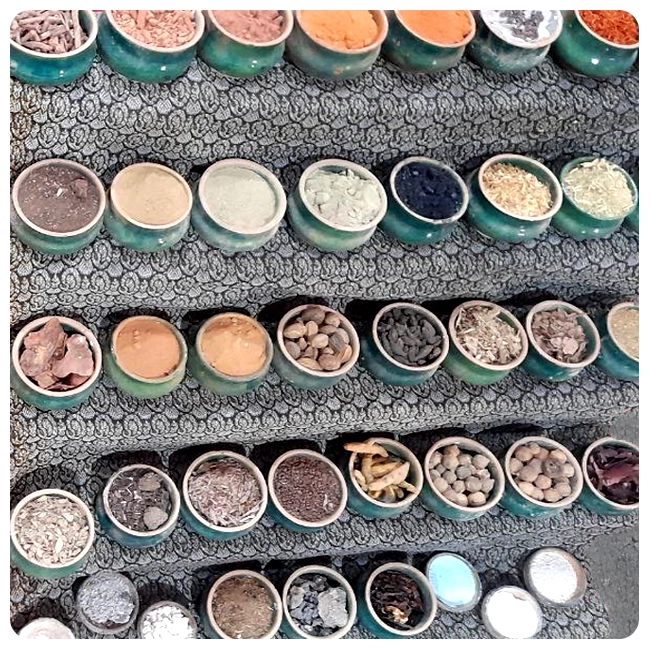
Valuable Iranian tribal rugs hold a distinct significance within each tribe and community in which they are produced or will be made. This value becomes particularly apparent when the power of imagination is harnessed in the design, intricate detailing, and arrangement of colors to create a unique harmony. Despite all stages being mentally woven through imaginary weaving, it presents a suitable opportunity to craft an unparalleled handmade artistic masterpiece of great worth. These rugs are not merely employed as simple floor coverings; instead, they are regarded as valuable works of art and handicrafts, showcasing the region’s rich artistic heritage and craftsmanship.
Four of the most well-known tribal carpet-weaving clans that are recognized, renowned, and highly valued are as follows:
Generally, the rugs woven mentally and by the nomadic tribes of Iran are referred to as “tribal rugs” or “nomadic rugs.” These rugs differ significantly from urban woven rugs, initially designed by a designer, drawn on a map, and then woven by a weaver.
The most famous tribal rug-weaving tribes include the Afshar, Qashqai, Baloch, and Bakhtiari tribes.
Nomadic tribes in the land of Iran weave carpets mentally, visualizing intricate patterns. They draw inspiration for carpet weaving from rare scenes rooted in picturesque natural landscapes, wildlife, and the objects they use throughout their lives. Each object is woven into unique symbols by different tribes, creating their specific meanings. Geometric shapes and angular designs are carefully incorporated into these patterns. These efforts will result in the most exquisite handwoven carpets crafted by Iranian nomadic tribes.
If you desire to fully experience the sense of authenticity and simplicity of past generations in the comfort of your home, and if you’re seeking a pristine and valuable artisanal craft rooted in the age-old traditions and authenticity born from life experiences within natural landscapes, we recommend considering an authentic Iranian tribal handwoven rug. Recognized and renowned worldwide, these rugs can be your finest choice.
Furthermore, as someone interested in art and humanity, it’s essential to know that nomadic artisans, especially women and young girls, utilize their imaginative designs and personal tastes to create valuable handicrafts beyond mere floor coverings. Through weaving these tribal rugs, they establish a form of local income for themselves, covering a portion of their family’s expenses.
Get informed about exclusive sales , free delivery and discount coupons %